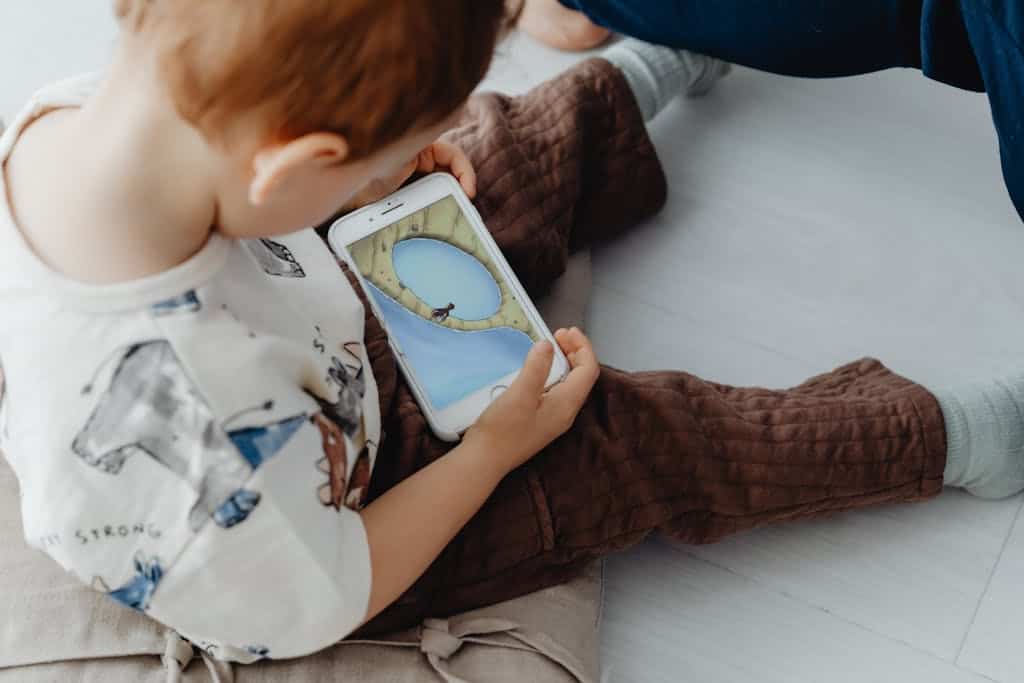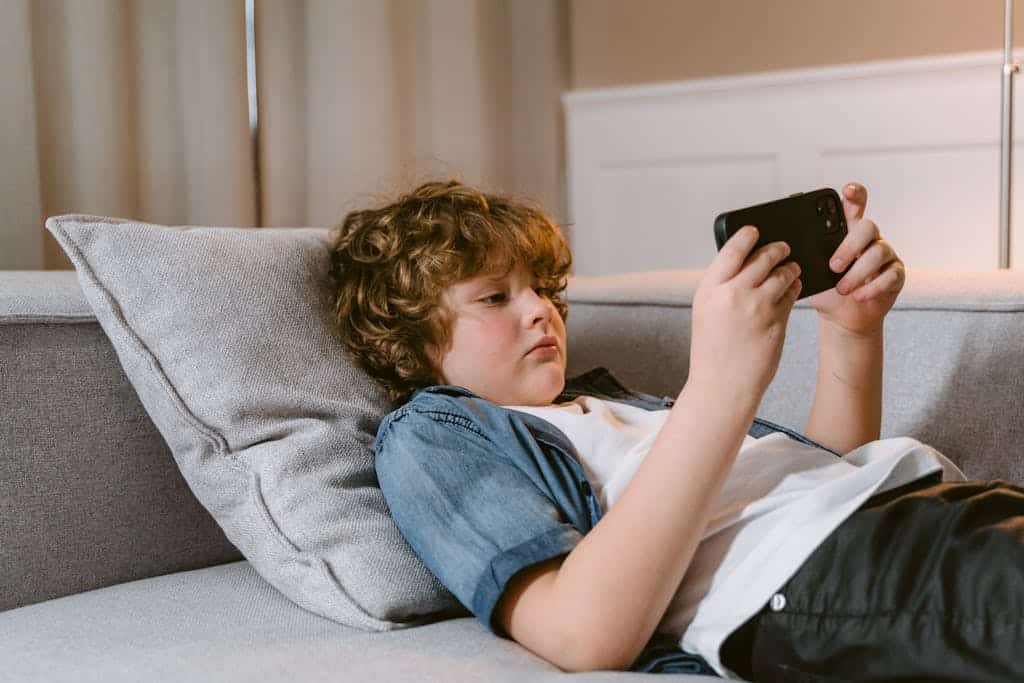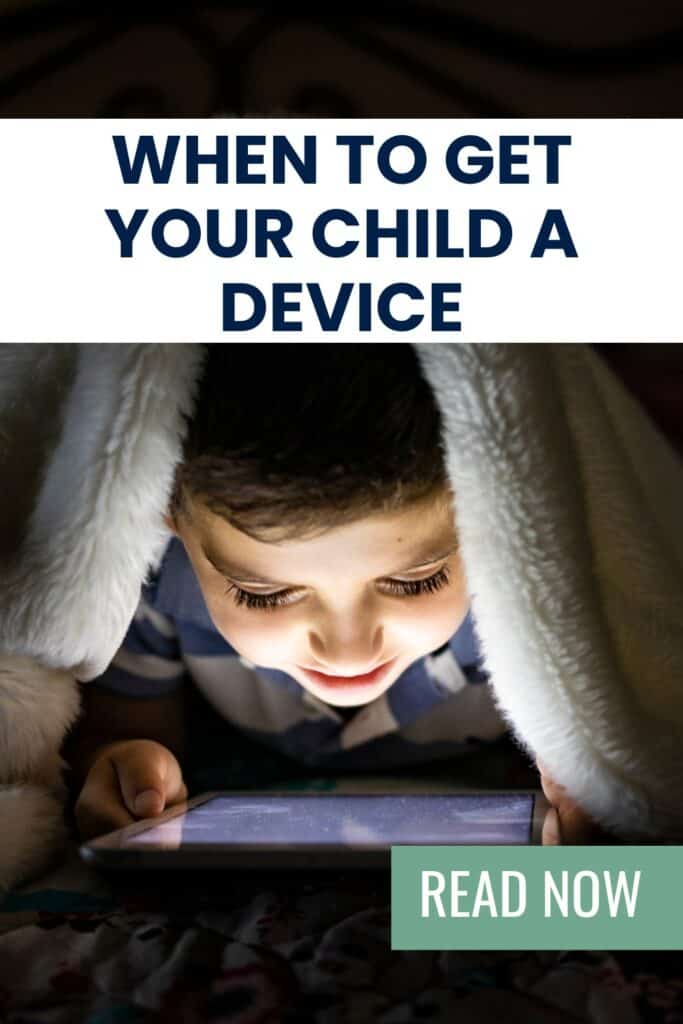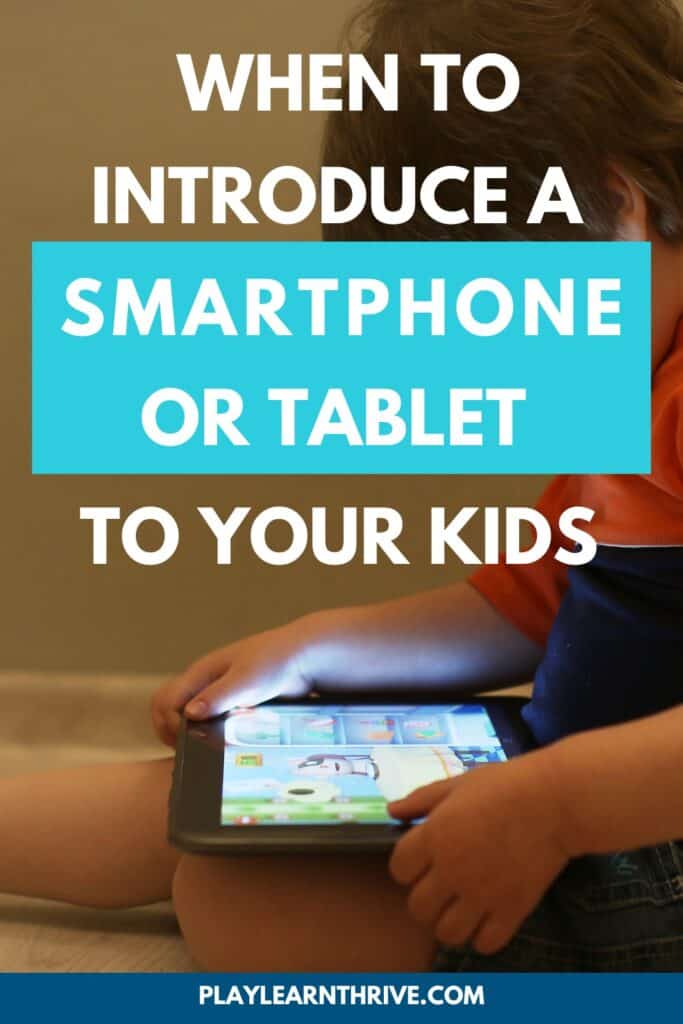When to introduce your child to a smartphone or tablet?
With technology becoming more and more a part of everyday life, it may seem like a good choice to introduce your child to technology early. But, studies show that early screen usage can lead to technology addiction and other problematic behavior. So let's talk about when to introduce your child to a smartphone or tablet.

How technology influences a child’s behavior and development
Play. Learn. Thrive.™ only endorses products we authentically love and use. Some of the product links in this post may be affiliate links. That means that if you click them and make a purchase, this site makes a commission. Play. Learn. Thrive.™ is also an Amazon Associate. As an Amazon Associate, we earn from qualifying purchases. It will have no impact on the price you pay or the experience of your purchase.
Technology plays a significant role in shaping a child's behavior and development, influencing everything from attention span and emotional regulation to social skills and cognitive growth.
Research shows that excessive screen time, particularly unregulated exposure to smartphones, tablets, and social media, can lead to increased impulsivity, difficulty with focus, and a reduced ability to manage emotions.
The instant gratification provided by digital devices can make it harder for children to tolerate boredom, engage in deep problem-solving, or develop patience and resilience.
Additionally, the nature of digital interactions—where communication is often filtered through screens rather than face-to-face—can impact social development, making it more challenging for children to read social cues, develop empathy, and build strong interpersonal relationships.
While technology can be a valuable tool when used intentionally, overexposure at an early age can disrupt natural developmental processes, hindering creativity, self-regulation, and real-world learning experiences.
New Common Sense Media Research Around Smartphone and Tablet Ownership
Recent data (March 2025) from Common Sense Media highlights the increasing prevalence of mobile device ownership among young children.
- Overall Ownership: As of 2024, 51% of children aged 8 and younger own a smartphone or tablet, up from 45% in 2017.
- Toddlers: 40% of 2-year-olds possess their own tablet device.
- By Age 4: 58% of children have their own tablet.
- By Age 8: Approximately 25% have their own smartphone.
You can read the complete study here.
These numbers are alarming and should serve as a wake-up call for parents. The rapid rise in early device ownership isn’t just a passing trend—it has serious implications for childhood development, mental health, and social skills.
Young children’s brains are highly sensitive to their environment, and heavy screen exposure during critical developmental years can interfere with attention spans, emotional regulation, and the ability to engage in deep, imaginative play.
When screens become the default mode of entertainment from an early age, children miss out on essential real-world learning experiences—like problem-solving, boredom tolerance, and independent thinking.
Transform Your Family’s Screen Habits

Are digital devices dominating your family interactions? It's time for a change. Our Family Reset Mini-Course offers practical, manageable steps to significantly reduce screen time while enhancing your family's connection.
Things to ask yourself before you buy a smartphone or a Tablet
Are you buying a tablet just to entertain your child?
It is very tempting to hand your child a tablet so that you can buy some quiet and get something done, but what are the costs of this to your child’s development.
Children who are always entertained, never learn to sustain themselves through periods of boredom to develop grit and persistence.
Who is benefiting from the tablet or smartphone?
The parent benefits the most from giving a child a device. The parent gets some quiet, more contained behavior while they attend to something they need to attend to.
At older ages, children could benefit some from learning how the technology works, but for very young children there is very little to no benefit from using smart devices.
Does your child really NEED IT?
Your child probably doesn’t need a device for themselves. The better policy is to have a shared family device that the parent can regularly check for correct usage and what content the child is watching.
Most experts agree that children under the age of preschool do not need any technology, especially tablets or smartphones. After preschool, very limited use is more appropriate.
No your child does not need a smartphone or tablet. If any tablet or smartphone is bought it should be a shared use device that the parents retain the majority of the control of.

The Negative Effects of Tablets and Smartphones
While smartphones and tablets are often marketed as educational tools or convenient distractions, the reality is that excessive early exposure can have significant negative effects on a child’s development. Here’s why parents need to be mindful of how and when they introduce these devices.
1. Shortened Attention Span
Tablets and smartphones provide instant gratification, with fast-paced apps and videos that constantly change scenes, colors, and sounds. This can make it harder for children to focus on slower, real-world activities like reading, creative play, or even simple conversations. Over time, too much screen time can make it difficult for kids to sustain attention, follow instructions, and engage in deep, focused thinking.
2. Delayed Social and Emotional Skills
Real-world social interactions—like making eye contact, reading facial expressions, and responding to emotions—are essential for children’s development. However, when children spend too much time on screens, they miss out on these face-to-face experiences. This can lead to difficulties in understanding social cues, managing emotions, and developing empathy, which are all critical for forming healthy relationships.
3. Increased Risk of Anxiety and Depression
Research has linked early and excessive screen exposure to higher levels of anxiety, depression, and mood swings in children. The more time kids spend on screens, the less time they spend engaging in physical play, outdoor exploration, and imaginative activities—all of which are crucial for emotional well-being. Additionally, as children get older, social media and online interactions can introduce unhealthy comparisons, cyberbullying, and a reliance on external validation.
4. Disrupted Sleep Patterns
Tablets and smartphones emit blue light, which interferes with the production of melatonin, the hormone that regulates sleep. When children use screens, especially before bedtime, they may struggle to fall asleep or experience restless sleep. Poor sleep directly affects mood, focus, and overall brain development, making it harder for kids to learn, regulate emotions, and function during the day.
5. Reduced Creativity and Independent Play
One of the biggest downsides of early device use is that it takes away time from open-ended, imaginative play. Instead of problem-solving, building, pretending, or exploring, children become passive consumers of digital content. Play is how kids learn to entertain themselves, develop independence, and build resilience—but when a tablet is always available, they may never fully develop these critical life skills.
6. Weakened Parent-Child Connection
Excessive screen time doesn’t just impact children—it also affects the parent-child relationship. When a tablet or smartphone becomes the go-to source of entertainment, children may engage less with their parents, missing out on bonding opportunities that are essential for emotional security and attachment. Additionally, when parents rely on screens to keep children occupied, they may unintentionally reinforce a disconnect in their relationship, leading to fewer shared experiences, meaningful conversations, and moments of connection. Over time, this can make it harder for children to turn to their parents for comfort, guidance, or emotional support.
What Parents Can Do
- Delay device introduction as long as possible, especially for toddlers and preschoolers.
- Prioritize real-world experiences over screen-based activities—play, reading, and outdoor time are far more beneficial.
- Set clear screen time boundaries and ensure screens aren’t replacing essential developmental activities like free play, family connection, and hands-on learning.
- Model healthy screen habits—children will follow your lead.
By being intentional about when and how you introduce screens, you can help your child develop focus, creativity, and emotional well-being—while also strengthening your bond as a family.

When is the best age to introduce a child to a smartphone or tablet?
There is no best age. It's best to delay introducing smartphones and tablets as long as possible. In the recent book The Anxious Generation, psychologist Jonathan Haidt explores the profound impact smartphones and tablets have had on children's mental health, cognitive development, and social well-being. I highly suggest you take the time to read the full book, but if you can't, here is a brief overview to explain why I'm suggesting you delay as long as possible.
Overview of The Anxious Generation by psychologist Jonathan Haidt
Haidt presents compelling research showing that the sharp rise in anxiety, depression, and attention issues among young people correlates with the widespread adoption of smartphones and social media.
He argues that children introduced to screens too early—especially unrestricted access to tablets and smartphones—experience diminished real-world interactions, reduced attention spans, and an increased risk of developing mental health struggles.
Haidt emphasizes that delaying exposure to these devices, setting firm boundaries, and prioritizing real-world play and social interactions are critical for fostering resilience and emotional well-being.
For parents questioning when to introduce your child to a smartphone or tablet, The Anxious Generation makes a strong case for waiting as long as possible and taking a highly intentional approach to screen use.
Instead of viewing these devices as an inevitable part of childhood, Haidt encourages parents to reclaim childhood as a time of creativity, independence, and meaningful human connection—before the constant pull of digital distractions takes hold.

50 Simple Screen-Free Learning Activities for Curious Kids
These 50 hands-on activities help children develop problem-solving skills, creativity, and real-world knowledge—without needing a screen. Designed to encourage self-directed play, hands-on discovery, and deep learning, this guide gives you a simple way to turn everyday moments into powerful learning opportunities.
What to Focus on Instead of Tablets and Phones
Rather than relying on tablets and smartphones for entertainment, parents can encourage activities that promote creativity, resilience, and real-world learning. Children thrive when given opportunities to explore, take risks, and engage in hands-on play. Here’s what to focus on instead:
1. Outdoor Play: The Ultimate Brain Booster
Time spent outdoors is one of the best ways to support a child’s physical, emotional, and cognitive development. Nature offers an endless supply of open-ended, sensory-rich experiences that screens simply can’t replicate.
Why outdoor play matters:
- Strengthens gross motor skills through running, climbing, and balancing.
- Reduces stress and improves mood by increasing exposure to natural sunlight.
- Encourages curiosity and problem-solving as kids explore their environment.
- Provides a healthy outlet for energy, reducing hyperactivity and meltdowns.
Instead of handing over a device, encourage your child to dig in the dirt, climb a tree, collect leaves, or simply run freely. Outdoor play is essential for fostering independence and self-confidence.
2. Risky Play: Building Confidence and Resilience
Children need opportunities to take risks and push their physical and mental limits. Risky play—such as climbing high structures, balancing on logs, or using real tools under supervision—helps kids develop confidence, assess danger, and build resilience.
Examples of safe, supervised risky play:
- Climbing trees or playground structures.
- Walking on uneven terrain like rocks or logs.
- Using age-appropriate tools (hammering nails, whittling sticks, or cooking).
- Rough-and-tumble play like rolling, wrestling, or chasing games.
Risky play helps children trust their instincts, problem-solve in real time, and overcome fears—all of which are essential life skills. Unlike screens, which offer passive entertainment, physical challenges empower children to take control of their own learning.
3. Unstructured & Independent Play: Letting Kids Take the Lead
Many parents feel pressured to constantly entertain their children, but unstructured play is actually one of the best things for their development. When kids are given free time without adult direction, they learn to entertain themselves, make independent decisions, and build problem-solving skills.
Ways to encourage independent play:
- Provide a play-friendly space with accessible toys and materials.
- Allow time for boredom—this sparks creativity!
- Step back and observe rather than directing play.
- Encourage open-ended storytelling, role-playing, and pretend play.
The key is to resist the urge to intervene too soon. If a child gets “stuck” or frustrated, encourage them to figure out a solution rather than immediately stepping in to help. This builds perseverance and confidence in their ability to handle challenges.
4. Open-Ended Toys: Encouraging Creativity & Problem-Solving
Unlike tablets and smartphones, which often dictate how a child should engage, open-ended toys allow for limitless exploration and creativity. These are toys that can be used in multiple ways, adapting to a child’s imagination rather than restricting it.
Examples of great open-ended toys:
- Building Blocks (wooden, magnetic, or LEGO-style) – Encourage spatial reasoning, problem-solving, and engineering skills.
- Loose Parts (rocks, shells, fabric scraps, cardboard) – Inspire imaginative play and creative construction.
- Art Supplies (paint, clay, markers, paper) – Support self-expression and fine motor development.
- Dolls, Figurines, & Puppets – Enhance storytelling, role-playing, and social-emotional learning.
- Outdoor Materials (buckets, sticks, water, sand) – Create opportunities for experimentation and discovery.
By filling your home with toys that encourage hands-on learning and problem-solving, you give your child tools to stay engaged and entertained without relying on screens.
The Bottom Line
Tablets and smartphones should never replace real-world exploration, movement, and hands-on play. Instead of relying on screens, prioritize outdoor adventures, risky play, independent exploration, and open-ended toys to help your child develop the essential life skills they need to grow into confident, capable, and creative individuals. These experiences not only support brain development but also strengthen family bonds and build lifelong resilience—far more than any app or digital device ever could.





